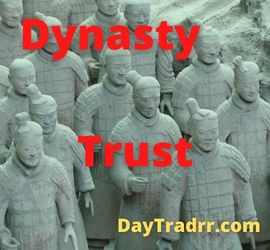What is a Dynasty Trust?
 A dynasty trust is a long-term trust established to convey wealth from generation to generation. It does this while avoiding transfer taxes such as the gift tax, estate tax, or generation-skipping transfer tax (GSTT) during the duration of the trust’s assets. The longevity of the dynasty trust is its distinguishing feature. If correctly constructed, it has the potential to survive for many generations, if not forever. A properly designed dynasty trust can theoretically continue in perpetuity.
A dynasty trust is a long-term trust established to convey wealth from generation to generation. It does this while avoiding transfer taxes such as the gift tax, estate tax, or generation-skipping transfer tax (GSTT) during the duration of the trust’s assets. The longevity of the dynasty trust is its distinguishing feature. If correctly constructed, it has the potential to survive for many generations, if not forever. A properly designed dynasty trust can theoretically continue in perpetuity.
Historically, trusts could only be established for a certain number of years. Many states have a law against perpetuities. These statutes specify when a trust has to terminate. For example, a trust might exist for 21 years after the death of the last beneficiary who was alive at the time the trust was founded. As a result, a trust may possibly endure for 100 years or so under these conditions. Nevertheless, some states have lifted these restrictions on perpetuities. This allows for individuals and families with the financial means to establish dynasty trusts that can last for many generations.
The initial beneficiaries of a dynasty trust are often the grantor’s children. A grantor is a person whose assets are used to create the dynasty trust. Following the death of the grantor’s last-child, the grantor’s grandchildren or great-grandchildren are usually the next beneficiaries. The functioning of the trust is overseen by a trustee nominated by the donor. Typically, the trustee is a bank or other financial organization.
Dynasty Trust – A Closer Look
A dynasty trust is a type of irrevocable trust. Grantors might impose rigorous or loose standards on how money is managed and disbursed to recipients. However, once the trust is financed, the grantor will have no authority over the assets. Once established, the donor will not be able to change the provisions of the trust. The future beneficiaries of the trust are in the same situation and are governed by the same rules and restrictions.
Nonetheless, a dynasty trust is a dynamic wealth transfer vehicle. It permits wealth to be passed down from generation to generation without incurring transfer taxation. For example, gift, estate, or generation-skipping transfer tax (GSTT). A dynasty trust is an irrevocable trust with no stated end date. Therefore, the trust lasts as long as there are assets in it.
Gift, estate, and GSTT taxes may still apply to assets transferred to a dynasty trust. However, this occurs only when the transfer is made and only if the assets exceed federal tax exemptions. The federal estate tax exemption is $11.58 million for 2020 and $11.7 million for 2021 as a result of the Tax Cuts and Jobs Act implemented in 2017. The amount is adjusted for inflation on a yearly basis.
Dynasty Trust and Taxes
Congress has the power to increase or decrease the inheritance tax exemption in future years. Conversely, congress could repeal the estate tax altogether. For the time being anyway, an individual can place $11.58 million in a dynasty trust without incurring these taxes. This can ensure financial security for his or her children or grandchildren and, in effect, their children and grandchildren. Furthermore, the assets placed in a dynasty trust, as well as any appreciation on those assets, are permanently excluded from the grantor’s taxable estate, giving additional tax relief.
A trustee may distribute funds from the trust to beneficiaries in accordance with the conditions of the trust. However, because beneficiaries have no control over the trust’s assets, it will not be included in their taxable estates. Similarly, the assets of the trust are immune from claims by a beneficiary’s creditors. This is because the assets belong to the trust, not the beneficiary. A dynasty trust, however, will still be subject to income tax. To minimize this, individuals frequently transfer assets to dynasty trusts that do not generate taxable income. For example, non-dividend producing equities and tax-free municipal bonds, to reduce income generation.
Income taxes are still due on income generated by trust assets. For this reason, people generally prefer to put non-income-producing assets into dynasty trusts—assets such as growth stocks that don’t pay dividends, or tax-free municipal bonds. It’s also common to transfer life insurance policies to a dynasty trust. After the policyholder’s death, the policy proceeds can be used to pay estate tax that’s owed on other assets in the estate. (Source: nolo.com)
New Laws That Favor Dynasty Trusts
The law against perpetuities is a legal concept used to prevent trusts that may possibly continue forever. However, even with this criterion in place, trusts can be created to survive for a long time. In effect, the rule stated that a trust could not endure more than 21 years after the death of a possible beneficiary who was alive at the time the trust was established. Some jurisdictions, such as California, have adopted a separate, simpler version of the regulation. It is called The Uniform Statutory Rule Against Perpetuities which enables a trust to last up to 90 years.
Approximately half of the states have abolished the ban against perpetuities entirely. This clearly paves the way for dynasty trusts. Some states, such as Delaware and Florida go even farther. They offer trust-makers enticing tax incentives and flexibility. They also provide strong protection if beneficiaries divorce or go into debt. These states’ financial institutions profit handsomely from the large fees they charge to handle dynasty trust funds. (Source: ibid)
Dynasty Trust & Beneficiaries
When properly established, a dynasty trust protects the beneficiary’s assets. This keeps them out of reach of the beneficiary’s creditors and not susceptible to partition upon divorce. The assets are available for the beneficiary’s use but sufficiently removed from the beneficiary’s control to retain these safeguards. A dynasty trust is superior to any insurance coverage a recipient may purchase. Furthermore, even if the overall assets dynamically increase in value, dynasty trust assets are not included in the beneficiaries’ estates.
Correctly crafted, dynasty trusts can ensure that the assets are not included in the beneficiaries’ estates at their deaths. Also, the trust assets avoid estate taxes at the death of each beneficiary. They do this by triggering an exemption of the generation-skipping transfer tax for the assets. A dynasty trust ensures that money is passed down through generations without being affected by transfer taxes. In 2020, the generation-skipping transfer tax exemption amount is the same as the lifetime gift and estate tax exemption limit. This is $11,580,000 per person.
Example: Outright Gift to a Dynasty Trust
John Smith Sr. gifts assets valued at $11,580,000 to a dynasty trust for the benefit of his child, Johnny Jr. The gift tax exemption and generation-skipping transfer tax exemption applies to the $11,580,000 gift to the dynasty trust. As a result, John Sr. has removed $11,580,000 from his personal estate without paying tax today. All assets in the dynasty trust will not be distributed in Johnny Jr’s. estate or his descendants’ estates. This feature provides asset protection and longevity for the trust.
To further illustrate, assume that Johnny Jr. consumes only the trust’s income during his lifetime as per John Sr’s wishes. Therefore, the entire principal amount remains in the trust. In this case, the principle of $11,580,000 passes to Jr’s son (Sr’s grandson) tax-free. Had John Sr. left the funds outright to Jr., they would have been included in his estate. Also, they would have been subject to possible federal and state estate taxes, before passing to the grandson. Assuming a flat 40% tax rate, the funds would have been eroded by $4,632,000, leaving $6,948,000 for Jr’s son, Johnny III.
Assume, like Jr., his son Johnny III consumes only income and leaves the principal intact. In another round of estate taxes at a 40% tax bracket, the tax at Johnny III’s death would be $2,779,200. This leaves only $4,168,800 of the initial $11,580,000 remaining. As illustrated above, avoiding the tax erosion at each generation is a powerful wealth transfer tool indeed.
Frequently Asked Questions
Who should consider a dynasty trust?
Individuals with sizeable taxable estates should think about ways to decrease or eliminate transfer taxes for themselves and future generations. Owners of family businesses are ideal candidates for dynasty trust planning. A dynasty trust has the potential to be an excellent fit for anyone who has considerable assets. They can pass assets on not just to their children, but also to their children’s children, and so on. Dynasty trusts are intended for long-term asset planning across generations.
How Long Can a Dynasty Trust Last?
Trusts could only continue up to 21 years after the death of the last beneficiary before state governments began to repeal the Rule Against Perpetuities. As a matter of fact, several states are repealing this provision entirely. A dynasty trust, for example, can extend up to 365 years in Nevada and 90 years in California. The length of time differs from one state to the next.
Is a Dynasty Trust a Good Idea?
A dynasty trust is an excellent choice for families looking to pass down assets from generation to generation. A dynasty trust may be a good alternative if you have a large estate and want to transfer wealth without incurring certain estate-planning taxes. To reiterate, dynasty trusts are irreversible. This implies that after you’ve established the terms of the trust, you won’t be able to change them. As a result, dynasty trusts may not be a suitable choice if changing family dynamics or asset structures may have an impact on your future goals.
Up Next: What Is an Unrealized Gain?
 An unrealized gain represents the day-to-day increases (or decreases) in an asset’s value, such as a stock. However, until the stock is sold for cash, the gain remains unrealized. As a result, an unrealized gain is often referred to as a paper profit. Conversely, an unrealized loss is referred to as a paper loss.
An unrealized gain represents the day-to-day increases (or decreases) in an asset’s value, such as a stock. However, until the stock is sold for cash, the gain remains unrealized. As a result, an unrealized gain is often referred to as a paper profit. Conversely, an unrealized loss is referred to as a paper loss.
Unrealized gains are prospective profits that exist on paper as a result of an investment. It is a growth in the value of an asset that has yet to be sold for cash. For example, a stock position that has grown in value but is still open. Only when a position is sold for a profit is the gain realized. Further, if an unrealized gain is not sold in time, the prospective profit may be lost. This can happen if the position drops in value and loses its profit value before it is sold. In general, investors hang on to unrealized gains when they believe the asset’s value will continue to rise. Otherwise, they would sell and pocket the proceeds. However, investors may prefer to hang onto equities that have appreciated in value because they do not want to pay capital gains taxes right immediately.




